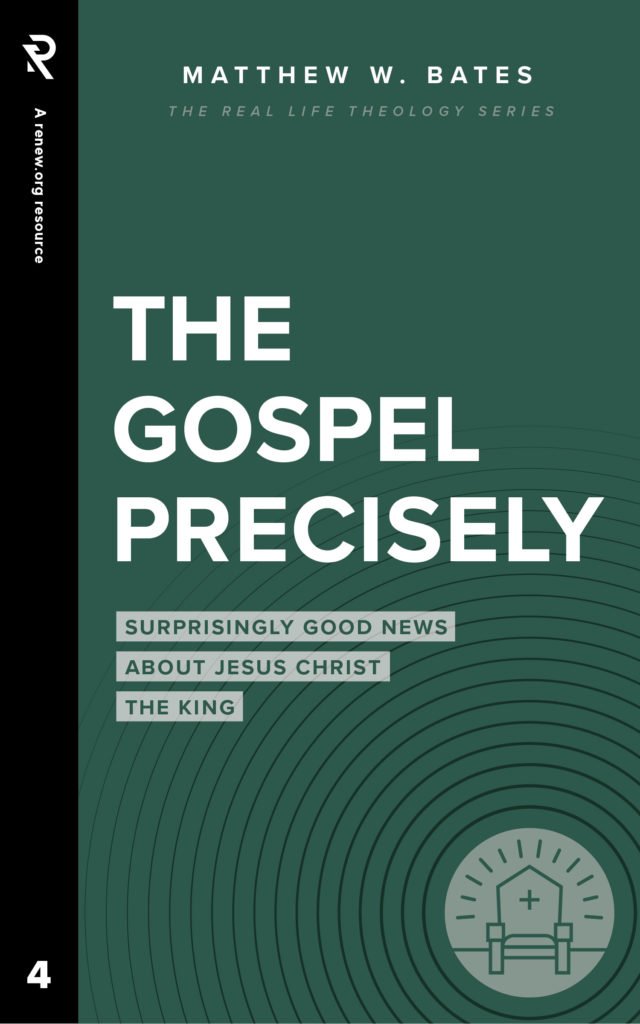
How Did Jesus Die for Our Sins?
How did Jesus die for our sins? He did it by first entering our human story and being everything we had been created to be but failed to be. Then he was crucified after a sacrificial pattern we see throughout the Old Testament in the Passover, sin offering, and Day of Atonement.
At the heart of Christian theology and Christian living is this truth: Jesus died for our sins.
This is, in fact, the most basic formulation of the meaning of Jesus’ death: As the apostle Paul put it, “For I handed down to you as of first importance what I also received, that Christ died for our sins according to the Scriptures, and that He was buried, and that He was raised on the third day according to the Scriptures” (1 Cor. 15:3-4).
Sometimes we can treat this as little more than a creedal statement that we say or sing about on Sundays, but never really give it much thought. “Of course Jesus died for my sins.” But the more fully we understand what this means, the more deeply it will affect our lives.
“The more fully we understand what this means, the more deeply it will affect our lives.”
So, exactly how was Jesus’ death for our sins?
To answer this question, we need to listen to a story, the biblical story.
This story will help us see how Jesus could die for our sins (that’s the first half of the article). And this story culminates in Jesus’ death and contains hints and shadows which show how Jesus could die for our sins (the second half of the article). Here’s the story which tells how Jesus was able to take our place.
For Our Sins: Not Giving Up on Humanity
In the beginning, God created the heavens and the earth, and he created human beings on the earth to be his partners in ruling over and caring for the earth and everything in it. God was King, and humans were to be his viceroys, extending his wise, generous, loving reign all throughout the earth.
But humans fell prey to the serpent’s temptation and broke faith with their Creator and King. This ruptured the partnership and unleashed wickedness and death on earth. Exiled from the Garden, humans would now die. But they would not be eliminated. God would not give up on them and his purpose for them.
“God would not give up on them and his purpose for them.”
Since humans were at the heart of the problem and since human partnership with God was God’s grand goal, the solution would come through a human. A human being—the “seed of the woman”—would crush the serpent, reverse the curse, and reconcile humans to God and restore them to their position as viceroys over the earth.
For Our Sins: Not Giving Up on Israel
So, in the course of time, God selected a man and his wife, Abraham and Sarah, through whom the promise of restoration would be carried forward. It was through his “seed” that all the earth would be blessed.
From this couple came the nation of Israel, the lineage of promise who were supposed to be the people of the solution. God called them to be his people, made a covenant with them, and gave them his Law/instructions so they could be a light to the world. And yet…
Israel too was infected with the human disease and repeated the sin of Adam and Eve. She broke faith with her Maker and King and violated the covenant, suffering its curses including the curse of exile.
But just as at the beginning, Israel would not be eliminated and God would not give up his purpose to bless the whole earth through her, through the seed of Abraham, through a faithful human being.
“God would not give up his purpose to bless the whole earth through her, through the seed of Abraham, through a faithful human being.”
So, “When the fullness of time came, God sent His Son, born of a woman, born under the Law, so that He might redeem those who were under the Law” and so that the “the blessing of Abraham” might come to the whole world (Gal. 4:4-5; 3:14).
For Our Sins: The True Israelite, the Faithful Human
Jesus was everything Israel was called to be but failed to be. Jesus was everything humans were created to be but failed to be.
Jesus was the faithful one who obeyed God to the full extent, all the way unto death, even death on a cross (Phil 2:8). It’s within this story that Jesus understood his mission and his death.
Jesus was the true Israelite, the ultimate seed of Abraham.
Jesus was the faithful human, through whom God’s reign and rule was to be extended on earth.
And Jesus was also so much more.
How did Jesus die for our sins? “Jesus was the faithful one who obeyed God to the full extent, all the way unto death, even death on a cross.”
Jesus was also the very embodiment of God himself (Col 2:9), the living, breathing, physical presence of God’s love, justice, and faithfulness come to be with us. God in the flesh, coming to do for humans what they couldn’t do for themselves.
Jesus’ death fulfilled God’s promise to deal with the curse of sin and death and defeat the devil. He was the seed of the woman who would crush the serpent’s head.
Jesus’ death culminated the story of Israel, exhausting the curse that lay upon her. And through all of that, it brought forgiveness and redemption to the world. He was the seed of Abraham through whom the whole world would be blessed.
That’s how Jesus died for our sins. Now let’s shift our focus to how he died for our sins. To get a grasp on how Jesus did this, we’ll look at three Old Testament events which provide “shadows” of which Jesus is the eternal reality.
How did Jesus die for our sins? Let’s look at the Passover.
This forgiveness and redemption is what Jesus had in mind when he refocused the Passover feast upon himself at the Last Supper and memorialized the meaning of his death:
“And when He had taken some bread and given thanks, He broke it and gave it to them, saying, ‘This is My body, which is being given for you; do this in remembrance of Me.’And in the same way He took the cup after they had eaten, saying, ‘This cup, which is poured out for you, is the new covenant in My blood…which is being poured out for many for forgiveness of sins.’” (Luke 22:19-20; Matt. 26:28b)
“Passover was the celebration of Israel’s redemption from slavery to Egypt.”
Passover was the celebration of Israel’s redemption from slavery to Egypt. It looked back as an experiential reminder that God had delivered them and made them his people. But because Israel had been unfaithful to living as the people of God, Passover in Jesus’ day also looked forward to a new and greater redemption, one that would free them from their sins and would make that forgiveness available to the whole world.
This is why the apostle Paul says, “Christ our Passover lamb has been sacrificed” (1 Cor. 5:7). He is the ultimate Passover lamb who delivers people from death and redeems them from slavery to sin and liberates them from the powers of evil.
How did Jesus die for our sins? Let’s look at the sin offering.
Jesus is also the ultimate sin offering who “bore the sin of many” (Is. 53:12). Jesus understood his death in terms of the Servant promised in Isaiah 53.
“He was pierced for our offenses, He was crushed for our wrongdoings; The punishment for our well-being was laid upon Him, and by His wounds we are healed. All of us, like sheep, have gone astray, each of us has turned to his own way; but the Lord has caused the wrongdoing of us all to fall on Him.” (Is 53:5-6).
As the Servant, Jesus would “give his life as a ransom for many” (Mark 10:45).
How did Jesus die for our sins? “He Himself bore our sins in His body on the cross.”
This apostle Peter has Isaiah 53 and the sin offering in mind when he writes, “He Himself bore our sins in His body on the cross, so that we might die to sin and live for righteousness; by His wounds you were healed” (1 Peter 2:24).
How did Jesus die for our sins? Let’s look at the Day of Atonement.
The Day of Atonement is at the heart of the apostle Paul’s magnificent description of Jesus’ death in Romans 3:23-26. Paul begins by summarizing the point he made in the first few chapters of Romans: All have sinned, whether the Jews who knew God’s Law or the Gentiles who didn’t. Everyone is guilty before God. But in his gracious love for us, God in Christ set out to solve that problem.
So, Paul says, Jesus’ death provided redemption by being a “propitiation” (Rom. 3:25; “sacrifice of atonement” in the NIV). This word links back to the annual Day of Atonement celebration explained in Leviticus 16. It was the day when the high priest entered the Most Holy Place in the Temple and sprinkled blood on the atonement cover on the ark of the covenant to remove the guilt of sin from the people so they could continue in a right relationship with God. The word “propitiation” in Romans 3:25 is the “atonement cover” of Leviticus 16.
“Those sacrifices pointed forward to a greater sacrifice.”
But as the author of Hebrews points out, the blood of bulls and goats could never take away sin. Those sacrifices pointed forward to a greater sacrifice. What the Day of Atonement looked forward to, Jesus’ death fulfilled once and for all.
And thus, Paul says in Romans 3:24, we can be justified. That is, we can be declared to be in good standing with God and his law. Free and cleared of all charges. We can now be reconciled to God, part of his people, and restored to partnering with him in his wise rule over this world.
Tracing the Shadows to Their Source
The Passover, the sin offering, and the Day of Atonement were all like a shadow that, if you traced it to its source, you would eventually get to the thing that cast the shadow. And that which cast the shadow was Christ who died for our sins. He took upon himself the condemnation that our disobedience and disloyalty to God had earned. The wages of sin is death, but that death sentence was carried out on him when he died on the cross (Rom. 8:1).
How did Jesus die for our sins? “The wages of sin is death, but that death sentence was carried out on him when he died on the cross.”
As the very embodiment of God himself and the full expression of God’s love and as the faithful one, Jesus took upon himself all our sin and the death that our sin deserved. He defeated the devil and all the dark powers that held us captive. Now our sins can be forgiven, and we can be set free to become the humans we were created to be.
Praise God that he didn’t give up on us!
For more from John, see johnwhittaker.net.









